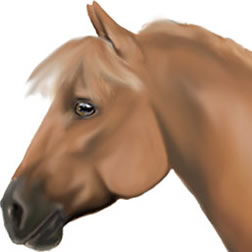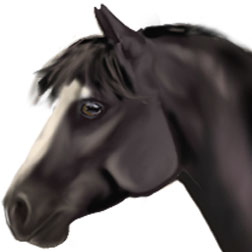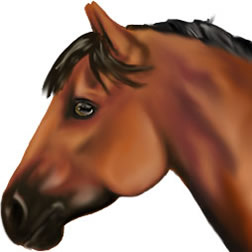|
|
|
|
|
|
|
|
 |
 |
 |
 |
Message thread at CPP
<< Back to previous page
*** Green Horse Green Rider ***
Real life horse training discussion group. This was the first thing that came up when I googled it. I didn't edit at all, just good ol' cut and paste! I like it because the woman who wrote this goes by the same method I like, be gentle, but if the horse is doing something dangerous, don't be afraid to increase pressure.
by Cheryl Sutor -- Trainer/Instructor
I began writing this article with aggressive, dis-respectful and stubborn horses in mind. However, it is important to realize that all horses should learn the lessons outlined in this article. Almost every horse that comes into training with me goes through every single step in this process on the very first day (and on subsequent days, if needed), whether I see behavior problems or not. It creates trust, respect and a high degree of obedience in the horse that is being trained.
If it is possible to avoid physically reprimanding a horse, then please do. I have always reserved physical reprimands for the most dangerous, seriously aggressive horses...and for situations that require that type of immediate response to avoid severely injuring myself, the horse or other people around me. But when these 2 situations do not apply, I use some simple, gentle training techniques to solve the aggressive/dominance problem, and to begin any horse on its way to becoming a great companion or competitor.
Many people have asked me "What is the specific cue you give to a horse to tell him to stop [biting, rearing, kicking, etc.]? There really is no one cue to reprimand a horse. What works for one horse, may not work for another. The most important thing to remember is that (if you decide you want to use physical contact to reprimand a horse) whatever cue you decide to use, use it consistently.
One thing is for certain, if you begin to reprimand your horse physically, it is important that you continue until he steps away from you and out of your personal space. If you stop reprimanding him before he has began to think that he is less dominant, you will have lost, and reprimanding him in the future may only become harder.
If you'd like to avoid reprimanding your horse with physical contact (which I recommend highly), you can do some basic ground exercises outlined below (do these steps in order, and don't continue to the next one until the horse has mastered the step before it). These exercises are not only geared towards correcting a horse's bad behaviors, remember, they are meant to be used in the training of any horse to become obedient and respectful.
STEP 1:
Be friendly. Every chance you can get, rub the horse all over his body, scratch his itchy spots and love on him like crazy. This will prove to the horse that you are a pleasure to be around. To gain any horse's respect, he must be able to trust that you are safe, and a pleasure to be around. If you are rubbing him and run into any area that he objects to being touched, just back off that area for a little while and go back to it slowly.
Once he will accept you rubbing him all over with your hands, begin to be friendly to him with other objects, rub him with ropes, saddle pads, bridles, saddles...whatever you are able to rub him with without hurting him. This step builds up trust.
STEP 2:
Teach him to give to pressure. This step can take several months depending on how much responsiveness you'd like in your horse. I would suggest you start with teaching the horse to give to pressure on his poll...to lower his head. When you ask your horse to give to pressure, it is MOST important that you do not release the pressure until the horse gives you the correct response. The first time you try this, you might end up standing there for several minutes with pressure on the horse's poll, but after the first few "gives" he'll soon learn the pattern well.
Once you teach him to give to pressure on his poll, you can teach him to give to pressure on his shoulder, hip, barrel, muzzle, legs...every part of his body. Make it a point to practice giving to pressure with your horse every day. It can be as simple as asking your horse to step to the side while you are grooming him, or to lower his head while you brush his face...practice makes perfect....and until the horse responds as desired 100% of the time, he has not learned it completely. This is the most time-consuming and patience-testing step in training horses, yet one of the most important.
The importance of this step is so great, I can't even begin to explain how essential it is in having an obedient, safe horse to be around. When your horse learns to give to pressure on nearly every part of his body, you will always have something to keep him busy with. In addition, when horses interact with each other they use physical pressure to indicate dominance. If horse "A" pushes on horse "B" and horse "B" moves away from the pressure, then horse "A" has successfully communicated to horse "B" that he is more dominant in the herd. Horse "B" then begins to respect the space and authority of horse "A", permitting that horse "A" is consistent in his communication.
STEP 3:
Alternate between steps 1 and 2. Take 5 minutes of every day you spend with your horse to review this step. Here is an example of what I might do during these 5 minutes: I'd start by being friendly, rubbing the horse on the shoulder. Then, after about 10 seconds, I'd stop rubbing and apply pressure with my fingertips on the horse's shoulder asking him to step away from the pressure. The instant he steps away, I immediate take away the pressure and begin rubbing his shoulder gently again. I repeat this over several areas of his body for an entire 5 minutes. Make this step part of your daily routine, and you will have the most responsive horse on the farm!
STEP 4:
Teach your horse the "back away" cue. This is the beginning of teaching your horse to respect your space. Start by standing about 3 feet in front of your horse facing him, holding the lead rope in your right hand. Leave some slack in the lead rope. During this exercise, the lead rope should never be taut. Hold your right hand up and point to your horse with your index finger, and begin wiggling the rope back and forth gently. If the horse just stands still, or if he does anything else but walk backward, wiggle the rope harder. If he still does not respond, wiggle harder.
The first couple times you do this exercise, you may have to resort to wiggling the rope so hard that it jerks on his halter enough for it to become extremely uncomfortable (not painful - but very uncomfortable). The wiggling will create a series of short jerks on his halter. Do not stop this wiggling until he shows signs of stepping backward. If he begins to lean backward, stop wiggling immediately, pet his face and praise him. Through repetition, the horse will soon learn to back up with only a slight wiggle of the rope, and over several sessions he may learn to back up with only a wiggle of your finger (this depends on how much work you do with him on this, and how consistent you are in your rewards).
STEP 5:
Teach that he can only be in your personal space under the following condition: he must do so respectively, and he must not enter your personal space unless he is invited in by your cue. Start by standing in front of him. Wiggle the rope (or your finger - depending on how much you've taught him) and ask him to step backwards, at least 10 feet from you (you may need a lunge line). The instant that he begins to walk towards you without you cueing him to do so, immediately ask him to back up to 10 feet again. Continue this until he can stand 10 feet from you without attempting to come into your space. Try tricking him by turning away or stepping back or to the side. You may find that he thinks that is the cue to advance into your space...but you must teach him that it is not his invitation!
Once he shows you that he can stand still at 10 feet away respectfully, you can give him the cue to step forward into your space. Until he can perform this exercise 100% respectfully every time, do not allow him to step any closer than 3 feet from you. Stop him about 3 feet from you by wiggling the rope (or your finger). Once he is standing still, you can then step toward him to pet him, which teaches him that it is pleasurable to respect your space.
If, at any instant the horse begins to disrespect your space by nudging you with his nose, by becoming stubborn to cues that you are positive he has learned, by tossing his head, biting, rearing, or any other aggressive behavior, immediately ask him to back up at least 10 feet away from you. It is important that you do this aggressively to get your point across. Once he is calm, standing 10 feet away obediently, you can repeat the exercise again.
Repeat this process until your horse can respect your space 100% of the time he is near you. I have yet to find a horse that this does not work on. However, you must incorporate it into your every-day routine for it to work. You cannot simply do the exercise one day, and expect the horse to be a perfect angel the next day. Horses learn through repetition, and it must become a part of your daily routine in order for the horse to learn it 100%. If you are leading your horse to the paddock or pasture, and he becomes a little strong or decides to push on you with his shoulder, or whatever behavior is unwanted...stop him and back him up away from you. Then, try a series of cues to get him to give to pressure, which will get his attention focusing back on you (instead of on the pasture or his buddies) before continuing on your way.
STEP 6:
Start to anticipate and correct every unwanted behavior in your horse, by giving him something to do before hand. A horse cannot be following a series of cues that you have taught him to obey and be misbehaving at the same time. So, give him a series of cues in a row to keep him busy, and to take his mind off whatever is distracting him. Keep your horse busy with responding to these cues as often as you can, until he begins proving to you that he can be obedient all the time. When he behaves obediently, you can let him rest from your series of cues. However, the instant that he begins to drift his attention to something else, or behave badly, begin your series of cues all over. The horse learns from this, that it is very hard work not paying attention to you. You will soon end up with the most obedient, respectful, safe horse you know. | 
mybuety & Pressed | | 2011-12-26 06:04:00 | | thank you all for your advice! i know she is that way. In lunging how do you get the horsse to step away from you? Missy doesn't like to unless she wants to or is trying to be dominant. ( she puts her head up over people and sometimes rears or tries to bite. She's reared on me twice but my dad was there then and when she puts her head up I make her put it down and when she tries to bite me I pop her.) I've gotten her to lunge with the whip before by slapping it on the ground and she backed away from me and started running but my dad (SUPER GREEN) kept confusing her and got in the why. Now she doesn't lunge when I whip it on the ground!
| 
Golden swallow & Bow tie | | 2011-12-26 14:56:16 | | Start from the beginning. I remember the first time I lunged beauty, I had some one helping me.
Wgat i'd do, is have somene run next to her, like you're leading, except your trotting. after a minute of that, the person running with her, starts moving away from her. If she tries to slow down, reinforce with your whip. That's for lunge line, if it's a round pen, i'd chase after her with the whip. Don't get to close, because she can kick out, but tap her with the whip and increase pressure until she moves away. She knows what to do, she just hasn't hadto do it the last few times. Treat her like a dog with training.(Not really but sorta.) with a dog and they do something good, you praise and treat. Horses though, when a horse does something good, you release the pressure, and in some cases, say good girl. sometimes though, you say good girl, and they stop. I'll look around for teqhniques. I've always wondered about how to teach a horse to lunge. I don't know if the way it was done with beauty is correct or not, i've just seen it done. | 
mybuety & Pressed | | 2011-12-26 19:19:10 | | | When lunging shake the lunge line and she should back up. Say 'back', shake the line, and walk forwards towards her with your arms out | 
MAC1023 & King | | 2011-12-26 21:02:15 | | Your horse might not be in sync with you. (not trusting)
You could try T-Touch- which is like massage for horses. You could also try joining up- which is when you put your horse in a round pen (any pen really) and you chase him around (without lunge on) untill you see your horse licking his lips or chewing. This means he understands your in charge and respects that. Then you turn and take a few steps. The horse should come to you... if not then you have to try it again! :) | 
MAC1023 & King | | 2011-12-26 21:06:25 | | thank you mybuety for that article that's what I REALLY SUPER REALLY needed!!!!! thank you sooo much!
GS gotta go work with Missy now! | 
Golden swallow & Bow tie | | 2011-12-27 14:48:22 | | | MAC, I was actually about to post about joining up. I don't know much about it, i've just heard of it. Does it really work as good as i've read it does? | 
mybuety & Pressed | | 2011-12-27 19:22:02 | | it's by Monty Roberts in california.
I have the video. for it. | 
Golden swallow & Bow tie | | 2011-12-29 00:47:37 | | | watching Clinton Anderson videos on respect and every one keeps walking in and commenting about his voice! | 
Golden swallow & Bow tie | | 2011-12-29 00:48:41 | | | Just an FYI, Clinton doesn't work for every horse. Beauty didn't like the trailering, she just looked like "What are you doing?" Missy though, it should work. So if she doesn't respond, it might not be you. | 
mybuety & Pressed | | 2011-12-29 05:31:53 | |
|
 |
 |
|
|
 |
 |
 |
 |
 |
 |
 |
 |
 |
 |
 |
 |
 |
 |
 |
 |
 |
 |
 |
 |
 |
 |
 |
 |
 |
 |
 |
 |
| |